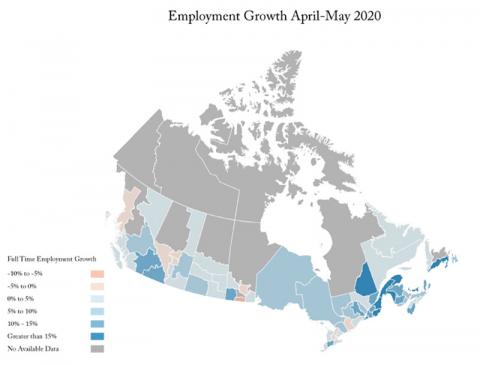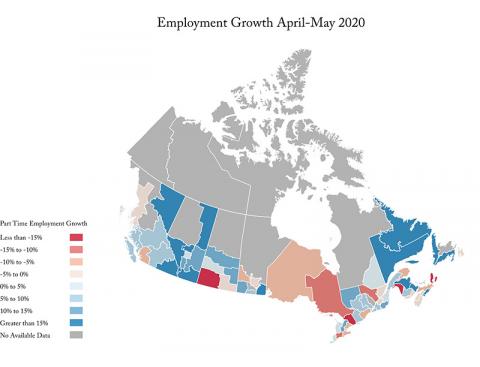From: Stéphanie Lluis
To: Canadians Concerned about the State of the Labour Market
Date: July 2, 2020
Re: Regional Differences in Job Growth Shows Ottawa Must Think Regionally
The massive and sudden drop in employment caused by the pandemic has been followed by uncertainty about when, where, and how quickly the economy is re-opening.
Collectively, these factors create a coordination problem in the labour market. This skews job losses in many parts of the country towards part-time workers, and the design of the Canada Emergency Response Benefit (CERB) further amplifies this part-time work disincentive. Governments need to address this.
The Canada Emergency Wage Subsidy (CEWS) program can help address the issue. Previous research shows that a policy that offers firms wage subsidies for new hires can bring the economy out of a low-employment rut. Financial support to overall payroll expenses allows firms to rehire workers who would otherwise remain laid off. This can be self-sustaining because when all firms rehire, the resulting rise in household incomes generates demand for goods and services, which supports employment.
EI’s work-sharing program, which has been adapted to address the current situation, is also useful as it enables employers to adjust their production and work arrangements to the reduced capacity required to operate under the strict COVID-19 safety restrictions. Yet, the CEWS has seen little take-up compared to the CERB.
The re-opening restrictions impose reduced capacity, which means businesses are limiting hours and/or employees. As the economy re-opens, therefore, available jobs are not going to be equally attractive in terms of work conditions, work schedule, and pay. This means unemployed job seekers on CERB may prefer to wait for better and safer job opportunities.
Currently, CERB discourages individuals to take up any part-time work that pays more than $1,000 a month because recipients lose their entire $2,000 monthly benefit at the first employment dollar earned beyond $1,000. This puts additional constraints on employers trying to hire at part-time hours and take advantage of the CEWS and/or the EI work-sharing programs.
Some economists have suggested CERB be modified to allow recipients to work more hours and earn more without losing all their benefits. This feature exists in the Working While on Claim program of EI and in many income support programs in other developed countries. There is evidence in some of these nations that subsidize short-hour/low-earning jobs, that encouraging part-time employment can help an unemployed worker find more stable employment, especially among the long-term unemployed.
Working While on Claim is designed to provide work relief as an alternative to public assistance or loans to individuals and firms as they navigate the economic hardship of recessions. Indeed, part-time employment typically increases during economic crises since it offers businesses the flexibility needed to adjust to business cycle fluctuations.
For example, part-time jobs in Canada grew by 25 percent during the financial crisis (November 2008-May 2009) while full-time employment dropped by more than 27 percent, resulting in a 17 percent decline in total employment. On the demand side, this may come from the fact that a higher share of full-time employees is more strongly affected by the cycle. On the supply side, in an environment of falling economic activity and/or rising unemployment, workers may be more willing to consider part-time work as an alternative to their preferred labour supply choice of full-time employment.
The May jobs report from Statistics Canada indicates some employment rebounds with variations by sector and province showing that the province of Quebec accounts for 80 percent of the employment gains. Did the employment gains affect full-time and part-time jobs similarly?
Figures 1 and 2 show a mapping of the April to May changes in part-time and full-time employment by economic regions. In Figure 1, employment gains (in blue) with respect to full-time work are spread across the country with the largest gains in Quebec and the Eastern provinces. Only a few regions are still experiencing employment losses (in pink) in full-time work. In contrast, from Figure 2 for part-time work, large employment losses (in red) are still taking place across the country. Except for parts of Western Canada, the region of Northern Quebec and some regions in the Eastern provinces which are seeing large gains in part-time employment, the losses of part-time jobs are large and taking place in all provinces.
Why isn’t part-time work picking up as much or even more broadly than full-time work, especially in the regions that re-opened sooner? Is it because the safety restrictions force businesses operating at lower capacity to reduce employee numbers rather than employees’ hours? Or are the part-time jobs available but vacant because job seekers are waiting for full-time and safer jobs while remaining under CERB?
Having more regionally disaggregated and timely data would help better understand the behavioural responses coming from CERB on the labour supply side and those coming from CEWS and work-sharing on the labour demand side. From a policy perspective the strong regional differences in part-time employment also suggests that any future modification of CERB in terms of clawback of benefits needs to consider tying the design of income support to the unemployment rate of the CERB recipients’ region.
Stéphanie Lluis is associate professor of economics at the University of Waterloo. Thanks to Ben Dachis and Parisa Mahboubi for useful comments, and the creation of maps to present the results.
To send a comment or leave feedback, email us at blog@cdhowe.org.
The views expressed here are those of the author. The C.D. Howe Institute does not take corporate positions on policy matters.
Figure 1
Figure 2
Source: Master Files of the Labour Force Survey through RTRA – Thanks to Eduardo Zhu for excellent research assistance.







